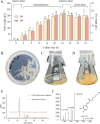In vitro strategy to enhance the production of bioactive polyphenols and caffeoylputrescine in the hairy roots of Physalis peruviana L
- PMID: 39528517
- PMCID: PMC11555210
- DOI: 10.1038/s41598-024-77698-8
In vitro strategy to enhance the production of bioactive polyphenols and caffeoylputrescine in the hairy roots of Physalis peruviana L
Abstract
The Rhizobium rhizogene-transformed root culture from Physalis peruviana L. (P. peruviana) may be a promising and novel source of valuable phenolics, including caffeoylputrescine (CP), which is known for antioxidant, antidiabetic, insect-resistant, disease-resistant, and neuroprotective properties. In this study, to improve the production efficiency of phytochemical components in P. peruviana hairy root cultures, we optimized various culture conditions, including the inoculum size, liquid volume, culture media type, carbon source, sucrose concentration, initial pH, and application of elicitors, to enhance the total phenolic content and CP yield in these hairy root cultures. The findings indicate that the use of sucrose as carbon source resulted in the highest biomass (13.28 g DW/L), total phenolic content (6.26 mg/g), and CP yield (2.40 mg/L). The White medium excelled in enhancing the total phenolic content (9.35 mg/g), whereas the B5 medium was most effective for the biomass (13.38 g DW/L) and CP yield (6.30 mg/L). A sucrose concentration of 5% was best for the biomass (18.40 g DW/L), whereas a sucrose concentration of 4% was ideal for the CP yield. Optimal culture conditions were as follows: an inoculum size of 0.5 g/100 mL, a liquid volume of 100 mL in a 250-mL flask, B5 medium, 4% sucrose, and a pH of 5.5. Among the tested elicitors, methyl jasmonate (MeJA) at 100 µM significantly increased the biomass (21.3 g/L), total phenolic content (23.34 mg/g), and CP yield (141.10 mg/L), which represent 0.96-, 2.12-, and 13.04-fold increases, respectively, over the control after 8 days. The optimized HR culture of P. peruviana provides a promising system to enhance the production of CP for pharmaceutical applications.
Keywords: Physalis peruviana L.; Caffeoylputrescine; Culture conditions; Hairy root; Polyphenols.
© 2024. The Author(s).
Conflict of interest statement
Figures




Similar articles
-
Effect of different Agrobacterium rhizogenes strains on hairy root induction and analysis of metabolites in Physalis peruviana L.J Plant Physiol. 2025 Feb;305:154431. doi: 10.1016/j.jplph.2025.154431. Epub 2025 Jan 10. J Plant Physiol. 2025. PMID: 39823760
-
Improvement of biosynthesis and accumulation of bioactive compounds by elicitation in adventitious root cultures of Polygonum multiflorum.Appl Microbiol Biotechnol. 2018 Jan;102(1):199-209. doi: 10.1007/s00253-017-8629-2. Epub 2017 Nov 14. Appl Microbiol Biotechnol. 2018. PMID: 29138909
-
Enhanced production of phenolic compounds in hairy root cultures of Polygonum multiflorum and its metabolite discrimination using HPLC and FT-IR methods.Appl Microbiol Biotechnol. 2018 Nov;102(22):9563-9575. doi: 10.1007/s00253-018-9359-9. Epub 2018 Sep 14. Appl Microbiol Biotechnol. 2018. PMID: 30218377
-
In Vitro Strategy for the Enhancement of the Production of Bioactive Polyphenols in Transformed Roots of Salvia bulleyana.Int J Mol Sci. 2022 Jul 14;23(14):7771. doi: 10.3390/ijms23147771. Int J Mol Sci. 2022. PMID: 35887119 Free PMC article.
-
Modifications in gene expression and phenolic compounds content by methyl jasmonate and fungal elicitors in Ficus carica. Cv. Siah hairy root cultures.BMC Plant Biol. 2024 Jun 10;24(1):520. doi: 10.1186/s12870-024-05178-2. BMC Plant Biol. 2024. PMID: 38853268 Free PMC article.
Cited by
-
Identification of the first plant caffeoyl-quinate esterases in Cichorium intybus.Front Plant Sci. 2025 Aug 20;16:1632036. doi: 10.3389/fpls.2025.1632036. eCollection 2025. Front Plant Sci. 2025. PMID: 40909896 Free PMC article.
References
-
- Verma, N. & Shukla, S. Impact of various factors responsible for fluctuation in plant secondary metabolites. J. Appl. Res. Med. AROMA2, 105–113. 10.1016/j.jarmap.2015.09.002 (2015).
-
- Isah, T. et al. Secondary metabolism of pharmaceuticals in the plant in vitro cultures: Strategies, approaches, and limitations to achieving higher yield. Plant Cell Tissue and Organ Culture PCTOC132, 239–265. 10.1007/s11240-017-1332-2 (2018).
-
- Veena, V. & Taylor, C. G. Agrobacterium Rhizogenes : Recent developments and promising applications. In Vitro Cell. Dev. Biol. Plant43, 383–403. 10.1007/s11627-007-9096-8 (2007).
-
- Rawat, J. M., Bhandari, A., Raturi, M. & Rawat, B. Agrobacterium Rhizogenes Mediated Hairy Root Cultures: A Promising Approach for Production of Useful Metabolites, in New and Future Developments in Microbial Biotechnology and Bioengineering, 103–118 (Elsevier, 2019).
MeSH terms
Substances
Grants and funding
LinkOut - more resources
Full Text Sources
Miscellaneous

